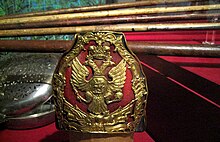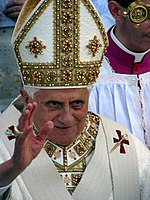Mitre
The mitre (Commonwealth English) (
Etymology
μίτρα, mítra (

Western Christianity
This section needs additional citations for verification. (July 2021) |
In its modern form in Western Christianity, the mitre is a tall folding cap, consisting of two similar parts (the front and back) rising to a peak and sewn together at the sides. Two short lappets always hang down from the back.
History
The camelaucum (
Worn by a bishop, the mitre is depicted for the first time in two miniatures of the beginning of the eleventh century. The first written mention of it is found in a Bull of Pope Leo IX in the year 1049. By 1150 the use had spread to bishops throughout the West.[citation needed]
In the
Use
In the
Three types of mitres are worn by Roman Catholic clergy for different occasions:
- The simplex ('simple', referring to the materials used) is made of undecorated white linen or silk and its white lappets traditionally end in red fringes. It is worn most notably at funerals, Lent, on Good Friday and by concelebrant bishops at a Mass. Cardinals in the presence of the Pope wear a mitre of white linen damask.
- The auriphrygiata is of plain gold cloth or white silk with gold, silver or coloured embroidered bands; when seen today it is usually worn by bishops when they preside at the celebration of the sacraments.
- The pretiosa ('precious') is decorated with precious stones and gold and worn on the principal Mass on the most solemn Sundays (except in Lent) and feast days. This type of mitre is rarely decorated with precious stones today, and the designs have become more varied, simple and original, often merely being in the liturgical colour of the day.
The proper colour of a mitre is always white, although in liturgical usage white also includes vestments made from gold and silver fabrics. The embroidered bands and other ornaments which adorn a mitre and the lappets may be of other colours and often are.
On all occasions, an altar server may wear a shawl-style veil, called a vimpa, around the shoulders when holding the bishop's mitre.
Heraldry
In
With his
-
Mitre simplex traditional style: White damask with its white lappets ending in red fringes.
-
Benedict XVIwearing a pretiosa: elaborately embroidered mitre.
-
Papal Arms of Pope Benedict XVI. The papal tiara was replaced with a bishop's mitre.
Eastern Christianity


The most typical mitre in the
History
Orthodox bishops started wearing mitres around the 16th or 17th century, but the date of adoption is disputed.[9] The use of headgear of any kind by the Byzantine church was a late development, and before the 1500s they wore no headgear.[9][10] Theodore Balsamon, Patriarch of Antioch (ca. 1130–1140) stated that the patriarch of Alexandria was the only Orthodox prelate to wear a hat during the liturgy.[9] This claim was repeated by Symeon of Thessalonica in the fifteenth century, who in his Concerning the Holy Temple, wrote that all Eastern hierarchs and priests, with the exception of the patriarch of Alexandria conduct sacred service with uncovered heads.[11][9][12][13]
Another evidence pointing to the lack of headgear among the Orthodox bishops was the complaint against John XI of Constantinople who was accused of copying the Catholic pope in wearing a mitre.[9] In 1585 a Russian envoy witnessed the patriarchs of Constantinople, Alexandria, and Jerusalem celebrated the divine liturgy together and only the Alexandrian patriarch wore a mitre.[10]
Some modern scholars believe that the mitre was first adopted among the Orthodox when Cyril Lucaris (previously patriarch of Alexandria) became Ecumenical Patriarch in the early 1600s.[9][14] Others instead claim that the mitre started being used after the fall of Constantinople (1453).[9][15] There are some examples of Orthodox religious headgear (and possibly mitres) as early as the 14th century, such as a fresco of Metropolitan Kalevit in the Kremikovtsi Monastery or the mitre donated to the patriarch of Belgrade by Katarina Branković.[16][17]
Some have hypothesized that shape of the mitres adopted after the fall of Constantinople was likely derived by the stemma, the Byzantine imperial crown. Together with other imperial-derived vestements like the sakkos, the crown-like mitre embodied the regality and richness of the defunct empire, of which the bishops inherited the legacy.[9][15][18]
In medieval Russia bishops wore hats with a fringe, but not a mitre. This is in contrast to Constantinople and most other Orthodox clergy who did not wear any headgear, and might be accounted for by the cold temperatures in Russia.[19][20] The mitre was first appeared in Russia with Patriarch Nikon, who adopted it from the tradition of the Patriarch of Constantinople. Initially, it was only worn by the Patriarch of Moscow, but it was soon adopted by the rest of the bishops, and a council in 1675 mandated the mitre for all bishops, following the Greek custom.[19][10] Mitres were also given to some archimandrites, by the decree of Peter the Great in 1705; in 1786 Catherine the Great awarded a mitre to her spiritual father, Archpriest John Pamphilov. In 1797 the decree of Paul I allowed the mitre to be awarded to archpriests as mark of special distinction.[10] In 1988, the Holy Synod of the Russian Church decided that the mitres of all bishops would be topped with a cross, which until then was reserved for the Patriarch (also granted to the metropolitan of Kiev starting in 1686).[19][10]
Use
The Eastern mitre is made in the shape of a bulbous crown, completely enclosed, and the material is of brocade, damask or cloth of gold. It may also be embroidered, and is often richly decorated with jewels. There are normally four icons attached to the mitre (often of Christ, the Theotokos, John the Baptist and the Cross), which the bishop may kiss before he puts it on. Eastern mitres are usually gold, but other liturgical colours may be used.
The mitre is topped by a cross, either made out of metal and standing upright, or embroidered in cloth and lying flat on the top. In Greek practice, the mitres of all bishops are topped with a standing cross. The same is true in the Russian tradition.[10] Mitres awarded to priests will have the cross lying flat. Sometimes, instead of the flat cross, the mitre may have an icon on the top.

As an item of Imperial regalia, along with other such items as the sakkos (Imperial dalmatic) and epigonation, the mitre came to signify the temporal authority of bishops (especially that of the Patriarch of Constantinople) within the administration of the Rum millet (i.e., the Christian community) of the Ottoman Empire. The mitre is removed at certain solemn moments during the Divine Liturgy and other services, usually being removed and replaced by the protodeacon.
The use of the mitre is a prerogative of bishops, but it may be awarded to
Military uniform

During the 18th century (and in a few cases the 19th), soldiers designated as grenadiers in various northern European armies wore a mitre (usually called a "mitre cap") similar in outline to those worn by western bishops. As first adopted in the 1680s this cap had been worn instead of the usual broad-brimmed hat to avoid the headdress being knocked off when the soldier threw a grenade.[21] The hand grenade in its primitive form had become obsolete by the mid-18th century[21] but grenadiers continued as elite troops in most European armies, usually retaining the mitre cap as a distinction.[22]
Militarily, this headdress came in different styles. The Prussian style had a cone-shaped brass or white metal front with a cloth rear having lace braiding;[23] the Russian style initially consisted of a tall brass plate atop of a leather cap with a peak at the rear, although the German model was subsequently adopted. The British style—usually simply called a "grenadier cap" instead of a mitre—had a tall cloth front with elaborate regimental embroidery forward of a sloping red back, lined in white.[24] Some German and Russian fusilier regiments also wore a mitre with a smaller brass front-plate.[25]
By the end of the 18th century, due to changes in military fashion, the mitre had generally given way to the

The mitre in its classic metal-fronted 18th century form survived as an item of ceremonial parade dress in the Prussian Leib-Grenadier No 1 and
Other uses
This section needs additional citations for verification. (July 2021) |

The bishop in the board game chess is represented by a stylised Western mitre having Unicode codes U+2657 (white) and U+265D (black): ♗♝.
The
Abbesses of certain very ancient abbeys in the West also wore mitres, but of a very different form than that worn by male prelates.
The
Notes
- Henry George Liddell and Robert Scott, A Greek-English Lexicon: μίτρα, accessed 17 December 2023
- Britannica2004, tiara
- ^ Encyclopædia Britannica https://www.britannica.com/EBchecked/topic/386220/mitre
- ^ BRITISH LUTHERANS HAVE NEW BISHOP
- ^ a b . Catholic Encyclopedia. 1913.
- ^ fiu.edu "Instruction", 1969, n.28.
- ^ Lartigue, Dictionnaire.
- ^ von Volborth, Heraldry of the World, p.171, shows the arms of Cardinal Francis Spellman with a mitre in 1967, just two years before the 1969 fio.edu Instruction.
- ^ OCLC 714724958.
- ^ Hilarion (Alfeyev) (January 3, 2015). "On the Sakkos and the Mitre". OrthoChristian.Com. Retrieved 2021-07-27.
- ^ "Metropolitan Hilarion (Alfeyev). On the Sakkos and the Mitre". OrthoChristian.Com. Retrieved 2021-07-27.
- ^ Simeon of Thessalonica Concerning the Holy Temple 45. Patrologia Graeca volume 155, 716D-717A.
- ^ Migne, Jacques-Paul (1866). Patrologiæ cursus completus: seu, Bibliotheca universalis, integra, uniformis, commoda, oeconomica omnium SS. patrum, doctorum, scriptorumque ecclesiasticorum. Series græca (in Greek). J.-P. Migne. p. 716.
- OCLC 936029715.
- ^ )
- ^ "Mitre, ceremonial head-dress of Orthodox Serbian Metropolitan bishop of Belgrade, made in 15th century by Countess of Celje Katarina Kantakuzina Branković". Twitter. Retrieved 2021-07-27.
- OCLC 714724958.
- OCLC 21593187.
- ^ a b c "Особенности богослужебного облачения Патриарха на Руси". Церковно-Научный Центр "Православная Энциклопедия" (in Russian). Retrieved 2021-06-28.
- ^ Yevgeny Golubinsky "History of the Russian Church", vol. II, M. 1997-98
- ^ ISBN 0-684-15130-8
- ISBN -2-203-14316-9.
- ISBN 1855321602
- ISBN 1 85532 515 2
- ISBN 0-214-65349-8.
- ISBN 0-85045-737-8
- ISBN 0-214-65349-8.
- ^ Charles Davis O'Malley, "Andreas Vesalius of Brussels, 1514-1564," (Berkeley: University of California Press, 1964).
References
- Herbermann, Charles, ed. (1913). . Catholic Encyclopedia. New York: Robert Appleton Company.
- Noonan Jr., James-Charles (1996). The Church Visible: The Ceremonial Life and Protocol of the Roman Catholic Church. Viking. pp. 191. ISBN 0-670-86745-4.
- Philippi, Dieter (2009). Sammlung Philippi - Kopfbedeckungen in Glaube, Religion und Spiritualität. St. Benno Verlag, Leipzig. ISBN 978-3-7462-2800-6.
External links
- Mitres—Photographs and descriptions of the different types of mitres
- Episcopal Mitre from Kavsokalyvia, Mount Athos
- Mitre worn by the Archbishop of Esztergom, the Primate of Hungary, at coronations of Kings of Hungary.
- Mitre worn by Pope John Paul I at his papal inauguration Mass Archived 2016-03-03 at the Wayback Machine. From the National Geographic book Inside the Vatican, 1991.




